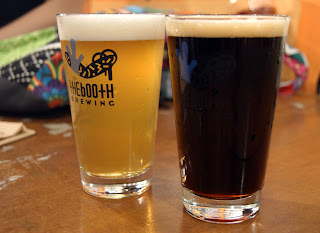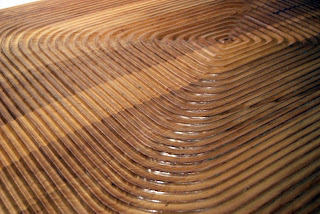Many pizza slices have been served to numerous party people
on many a late nights. Most people who have ever stayed out till the morning
hours in Hongdae’s clubs and drinking places,
are already very familiar with The Booth and its pizza-providing sister company
Monster Pizza.
We had the great joy of
visiting The Booth in one of the alleys in Noksapyeong. The pizzas are provided
by Monster Pizza and taste good as ever. Still, the real gem of The Booth
Noksapyeong is their craft beer. Their input in the crafting process both in
Denmark and South Korea, their meticulous shipping-regulations for how the
craft beer is supposed to be brought all the way to Noksapyeong, and finally
the enthusiasm of the owner and the staff all contribute to create an amazing
pizza joint.
Some of their beers are brewed
in collaboration with their Danish partner Mikkeller in Denmark. The other part
is brewed in South Korea in the Pangyo area. The people behind The Booth have
come up with some of the craft beer recipes in collaboration with their
partners to create flavors that go well with their pizzas. The transport-rules
are very minute. At no point in the transportation-process does the beer reach
above refrigerator-temperatures. The Booth calls this “The Cold Chain”. Even the beer batches that are shipped all the
way from Denmark to Seoul still adhere to these rules. This is all to ensure
that the customer at The Booth will get the best beer possible. The manager
tastes every keg of beer to see if there is the smallest of flavor
discrepancies and would toss the whole keg if any such taste flaw is detected.
The pizzas come in about three
different flavors and both sauces and grated cheese can be found at every
table, so that you can fill up to your heart’s content. My personal favorite is
the basic peperoni pizza, since I have gotten pretty tired of all the
Korean-style take-out pizzas with sometimes close to 20 toppings on one. The
Booth keeps the ingredient quantity down and instead focuses on the quality of
every dish and drink they serve.
The beer selection varies from
week to week and sometimes even daily. The beers on tap are also different from
store to store in the six spots that The Booth exists in. It is up to the store
manager to decide what beers suit the location, the clientele, the weather etc.
They are kind enough to update the tap list daily online, so you can check
which store serves which beer on a particular day and head straight there!
The Booth was initially
founded by three people. Two of them later came to marry each other. Out of
these three, interestingly one was a Korean medicine practitioner and one was a
write for The Economist. They identified both a lack of craft beers in Korea
and a premonition that a craft beer trend would start sooner or later.
The ambiance is very laid back
with two different rooms to eat in. The walls are decorated with graffiti, and
the keen eye might find bicycle equipment and clothes hung to one part of the
wall. The Booth actually runs a bicycle club that anyone from any skill level
can join.
Website: http://www.thebooth.co.kr
Instagram: https://www.instagram.com/theboothbrewing/
Locations: Noksapyeong, Gangnam x2, Konkuk University,
Samseong station, Itaewon station
Opening Hours:
Monday: 12:00pm ~ 1:00am
Tuesday: 12:00pm ~ 1:00am
Wednesday: 12:00pm ~ 1:00am
Thursday: 12:00pm ~ 1:00am
Friday: 12:00pm ~ 2:00am
Saturday: 12:00pm~ 2:00am
Sunday: 12:00pm ~ 12:00am



















































